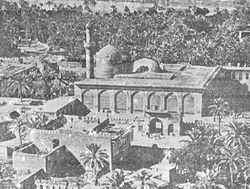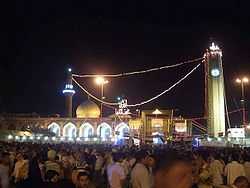Abu Hanifa Mosque
| Abu Hanifa Mosque | |
|---|---|
|
Abu Hanifa Mosque | |
| Basic information | |
| Location |
|
| Geographic coordinates | 33°22′18.12″N 44°21′29.88″E / 33.3717000°N 44.3583000°ECoordinates: 33°22′18.12″N 44°21′29.88″E / 33.3717000°N 44.3583000°E |
| Affiliation | Sunni Islam |
| Architectural description | |
| Architectural style | Islamic |
| Specifications | |
| Dome(s) | 4 |
| Minaret(s) | 2 |
The Abu Hanifa Mosque (Arabic: مسجد أبو حنيفة, masjid abū ḥanīfah or مسجد أبي حنيفة, masjid abī ḥanīfah) is one of the most prominent Sunni mosques in Baghdād, Iraq.
It is built around the tomb of Abū Ḥanīfah an-Nuʿmān, often called the "Great Imam" (al-imām al-aʿẓam), the founder of the Ḥanafī madhhab or school of Islamic religious jurisprudence. It is in the Sunni-dominated Al-Adhamiyah or al-Aʿẓamiyyah district of north Baghdad, which is named after Abū Ḥanīfah's byname of al-imām al-aʿẓam.
History

Imam Abu Hanifa died and was buried nearby in 105 AH / 767 AD. The small town of al-Adhamiyah grew up around the shrine. In 459 AH / 1066 AD, the mosque was restored by Sharaf al-Mulk Abu Sa’id al-Khwarizmi, who added a large dome and constructed the adjacent madrasa for followers of the Ḥanafī madhhab.
References
| ||||||||||||||||

.jpg)
